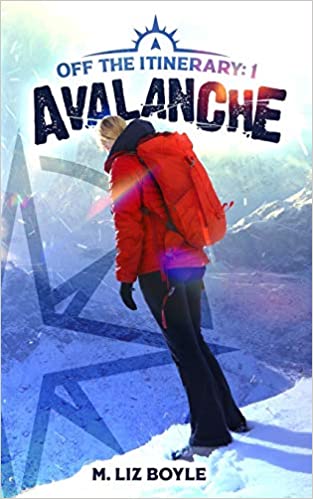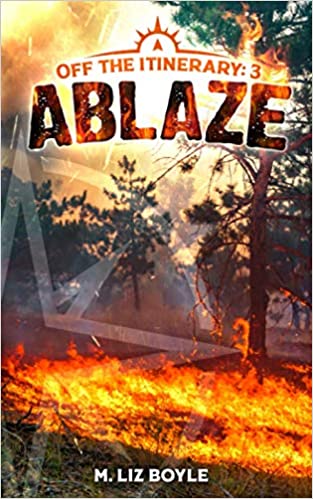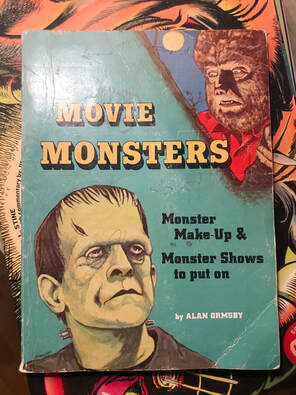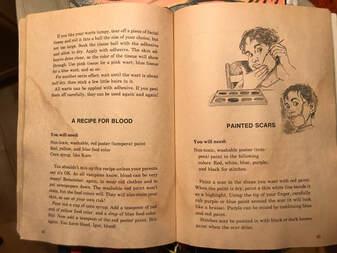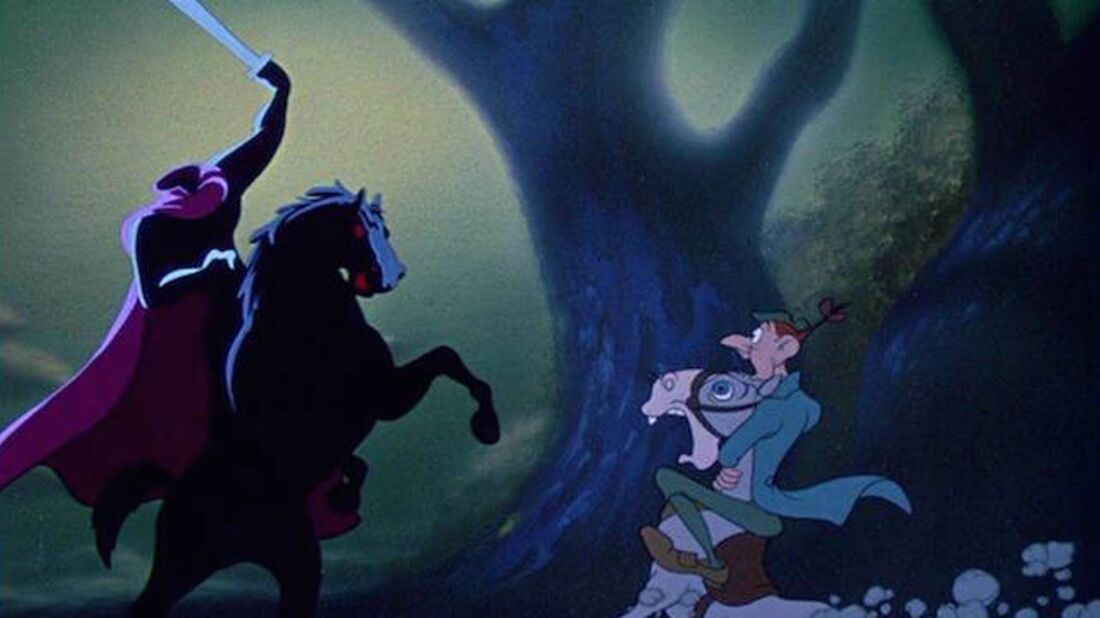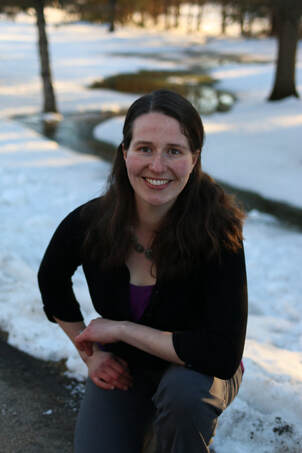 Today I'm doing something completely different and hosting my very first guest post on this blog. This post comes from author M. Liz Boyle. Liz is the author of the Off the Itinerary fiction series for young adult readers, the wife of a professional tree climber, and the mom of three energetic and laundry-producing children. Liz resides with her family in Wisconsin, where they enjoy hiking and rock climbing. Liz and her husband have also backpacked in Colorado and the Grand Canyon, which have provided inspiration for her writing. She makes adventurous stories to encourage others to find adventures and expand their comfort zones (though she confesses she still needs lots of practice expanding her own comfort zone). Hey, readers, writers, and adventurers! Thanks to Kevin Miller for the opportunity to guest post. Today’s topic? Engaging the senses to immerse readers in our stories. As an energetic hiker, wannabe climber, national parks traveler, and always-ready-for-the-beach girl, I love outdoor adventures. As a writer I love sharing adventures and inspiring others to experience their own. When I write adventure stories, I want my readers to feel the adrenaline surge, hear the roar of the snow, see the rush of floodwater, and feel the heat of the flames. I want my readers to grow from the experiences along with my fictional characters. Playing to the senses helps readers engage in the characters’ adventure. Think about how much of life is experienced through our senses. Imagine if fruits and vegetables were all gray, or if all food tasted like broth. Imagine if you couldn't feel the horse’s mane, smell the cookies baking, or hear your favorite song or the birds’ music. Our senses enrich our whole lives, and sprinkling sensations into our writing enriches our stories. Life without senses would be woefully boring. Now I’m not saying that people lacking a sense or more have less enjoyment in life. Not at all. In fact, they may enjoy life more than someone with all their senses because they’re so in tune to the senses that do function. Readers love to get lost in a story, and authors can use sensory descriptions to make that happen. So, as authors, how do we write scenes that totally immerse the reader in the story? Let’s study a few passages. Sight
Smith could’ve written, “Holly Angelo was tall and gangly,” but with this vivid description, we can see her in our mind’s eye.
This description makes it clear what the narrator’s eyes look like, and also what she thinks of her eye color, so it does double duty and never even uses words like brown, green, or gold.
I don’t have to have to be told that there’s high energy in the scene, because I can picture them scrambling out and up the hill. Feeling
With this description, we can put ourselves in Peak’s climbing boots and feel the aching muscles right alongside him. Obviously this is much stronger than saying, “All my muscles hurt.”
Smell
Khoury didn’t say, “Dad smells like a garage,” and I think we all agree that this detailed description puts us in the narrator’s spot, breathing in the specific smells around her. Hearing
I feel like I’m clutching the radio, straining to hear my own dad, much more poignantly than if the author had said, “We had a bad signal.” Taste
This weary-of-turkey description simply and effectively puts readers in the narrator’s place at the table.
Okay, So What Next? Looking through these examples that transported me (and hopefully you, too) into the scenes, one thing that hits me is the absence of some of the most obvious key descriptive words. In the Sight excerpts, Smith didn’t tell us Holly is tall and skinny; he showed us by comparing her to a scarecrow and a daddy long legs. Moving onto the eye color example, Carlson didn’t use a single color’s name, but instead compared the hazel eyes to a watercolor mess. We can imagine the color without being told the color! In the feeling excerpts, none of them contain words like hurt or pressure. Instead, the authors again used comparisons to explain. It’s one thing to say “it’s wet and blustery,” but by comparing the wind to getting slapped with a wet towel, readers can experience the weather as the character does. In the smelling example, the author doesn’t give any indication to whether these scents smell good or bad. They don’t smell nice, and they don’t stink. Instead, we’re told exactly what the smells are and that they’re familiar smells to the main character. It puts us in her shoes. In the hearing example, we aren’t told, “It was hard to hear him,” or “His voice was faint through the static.” With the blasts and pops, we know it was hard to hear him, and we know how badly she wants to hear his voice! In the taste excerpts, I again noted that we aren’t told if the food tasted good or bad or boring or overcooked. We can imagine the seasoned turkey and the soft, melted granola bar because that’s what is said. For authors, I think this means that we should focus on explaining sensations without using obvious descriptors. Don’t tell me she’s tall, show me what she looks like. Don’t tell me your legs hurt, show me how bad they hurt. Don’t say he smells woodsy, tell me exactly what he smells like. Instead of telling me the cell service is spotty, show me how impossible it is to communicate. Instead of telling me the food is good or bad, show me that there’s not a bite left or that nobody asks for seconds even though they don’t act full yet. This exploration of descriptions has made me realize that comparisons are often more effective than a string of carefully chosen adjectives. I’m not by any means casting off adjectives (they are perfect in many situations), but I am suggesting that as writers, when we want to launch our readers into our scenes, let’s describe scenes with comparisons and clear explanations. Readers, what are some of your favorite sensory descriptions you’ve read? Writers, what are some of your best descriptions? To learn more about Liz, visit her Amazon author page or her personal website.
0 Comments
I gave myself 20 days to do it, and I managed to complete it in 7. What a good feeling! The manuscript came in at 60,744 words, which makes it the longest book in the Milligan Creek Series to date by about 5,000 words. (Snowbound! was the longest book before this.) That word count is certain to change as I begin the revision process, though which direction it will go won't be clear until I have a chance to read the entire manuscript through from start to finish, which I plan to do tomorrow. That'll show me where it's running long, where I haven't explained things thoroughly enough, and so on. However, I'm hoping that when all is said and done, it'll come in about 1,000 words shorter than it is right now.
Meanwhile, it's time to step away from the computer and celebrate this milestone--starting by showering and eating lunch (I'm still in my pajamas because I didn't want to break my momentum). I like to joke that being an author involves days and nights of misery punctuated by brief moments of despair--and then something really bad happens. So, as difficult as writing is, when something good happens, such as completing a draft, celebrating is not an option. This is my seventh novel in the last five years, which feels like an amazing achievement considering I mostly write these books in my spare time. Hopefully it inspires other aspiring writers out there to go for it. You don't know what you're capable of until you try. I have always been fascinated by special effects and movie makeup effects. That fascination began quite early thanks to the Scholastic book order service at school, through which I managed to get my hands on this book (which I still have). By the time I was in grade 4, names like Lon Chaney (Sr. and Jr.), Boris Karloff, Bela Lugosi, Fredric March, Tod Browning, and other classic stars of old horror and monster movies were probably more familiar to me than they should have been. Not only did this book introduce me to all of the classic movie monsters, it also showed me how to transform myself into some of them. The cool thing is, a few years ago, my youngest daughter stumbled across this book on my shelf and developed a fascination with it as well. I'd like to think it's partly responsible for her current fascination with all things makeup, although she's more focused on making people beautiful rather than making them ugly. But there's always hope . . .
I'm not sure how things work in your household, but when it comes to holidays in our home, we have a list of films or TV shows that we absolutely must watch in order to ring in the season. Our Halloween list is much shorter than our Christmas list, but at the top of that list is the Disney version of The Legend of Sleepy Hollow. Not only is this a hilarious take on the classic Washington Irving tale, the music--sung primarily by Bing Crosby, who also narrates the film--is supreme. If you've never seen this film, you can preview it here. I promise you won't be disappointed.
|
Kevin MillerBrief thoughts and updates on writing, publishing, and life Archives
June 2024
Categories
All
|
 RSS Feed
RSS Feed
